|
|
GammaTech Durabook S15C
Reasonably priced, well-made, high-performance, magnesium alloy-bodied semi-rugged notebook with large wide-format 15.6-inch display
(by Conrad H. Blickenstorfer; photography by Carol Cotton)
Here at RuggedPCReview.com we're often asked what rugged computer is best, or which particular model to buy. The answer is always the same—"It depends." Unlike standard notebooks which generally live a pampered life on desktops, laps and perhaps a field office or class room, rugged computers may encounter a very wide variety of conditions. Those conditions can range from mild (use in a field office) to specific (like use in a vehicle) to truly extreme. Truly extreme costs more (and often much more), and truly extreme also means compromise. It's a bit like deciding if you need a hardened military vehicle for a job, or if perhaps a standard SUV will do. The latter has some limitations off-road, but it costs a lot less and it may have more features to boot. The folks at GammaTech USA know that and, in addition to industrial and application specific/mission critical systems, offer a range of durable and semi-rugged systems that do the job without breaking the bank. The Durabook S15C, introduced in February of 2011, is such a machine.

The Durabook S15C
The GammaTech Durabook S15C is a full-size notebook with a big 15.6-inch wide format screen. It measures 14.6 x 10.9 x 1.5 inches and weighs 6.5 pounds, making it a bit thicker and heavier than a standard consumer notebook, but not by much. It is quite elegant with a semi-matte very dark gray body and a large silver insert on top. The look perfectly captures this Durabook's purpose of being about halfway between a standard full-function consumer notebook and a fully rugged and heavily fortified one.
All the conveniences and features of a consumer notebook are there: a very legible full-size keyboard, a suitably large and quick hard disk (ours had a 320GB), a DVD multi drive, a wealth of card readers (ExpressCard, Smart Card, 4-in-1 multi-card, SIM), enough memory (up to 8GB of speedy DDR3), and plenty of onboard connectivity both wired and wireless. GammaTech always offers your choice of Intel's latest processors, and so customers have their choice of Core i3, i5, and i7 chips. Our tester came with a 2.53GHz Core i5-460M dual-core processor that represents a mid-range configuration for the S15C.
The Durabook S15C has a magnesium alloy case, very solid display hinges, rubberized overmolding around the bottom edges and corners, and it generally feels very solid. Note, though, that ports and card slots are open and do not have sealing or protective doors. This is not a sealed machine. Instead, GammaTech designed it to be "spill-resistant," i.e. it can handle the typical coffey and soda spills and perhaps a bit of rain, but not more than that.
Design, look, and feel
Below you can see the GammaTech Durabook S15C from the top and all four sides. The magnesium alloy case is light, yet, GammaTech points out, many times stronger than ABS plastic. The computer doesn't flex and twist like most plastic consumer laptops. The top of the LCD case is matte silver with black plastic top and badge holder. The top could perhaps be a bit more contoured so as to add extra stiffness and better project the tough tool-for-the-job look common in most semi- and fully rugged notebooks. The LCD hinges offer just the right degree of resistance when opening and closing the computer. When you close the lid, two small latches snap into place, securing the LCD case in place when in closed position. To open the notebook again, you simply pull.
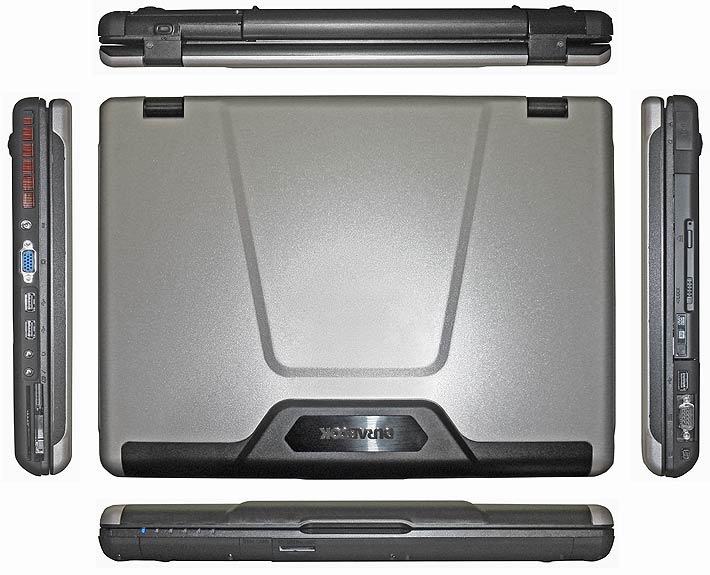
Ports and connectivity are located on the left and right side and the front of the computer. All ports are exposed, except for the LAN and modem port on the right that has a detachable protective rubber plug.
The two pictures below show a more detailed view of the left and right side of the Durabook.

On the left side (above), from left to right, are vents for the unit's heat exchanger fan, the power jack, a standard VGA port, two standard USB 2.0 ports, separate headphone and microphone jacks, an ExpressCard 34/54 slot, and a Smart Card socket.

On the right side, from left to right, is a IEEE1394 "FireWire" port, a standard 9-pin RS232 serial port, a third USB 2.0 port, the unit's optical drive (a DVD Super Multi writer in our evaluation machine), and next to that an RJ11 modem jack and a RJ45 gigabit LAN jack. The latter two share a detachable (and thus easily lost) protective rubber plug.
On the front of the machine you find a 4-in-1 card reader. The four formats supported are MMC, SDHC (a 32GB card read fine), as well as the Sony Memory Stick and Memory Stick Pro. There are also six indicator lights (power status, WiFi, rotating media operation, num-lock, caps lock, and battery status (green to orange to red)).
Below you can see the bottom of the Durabook S15C with its access covers removed.
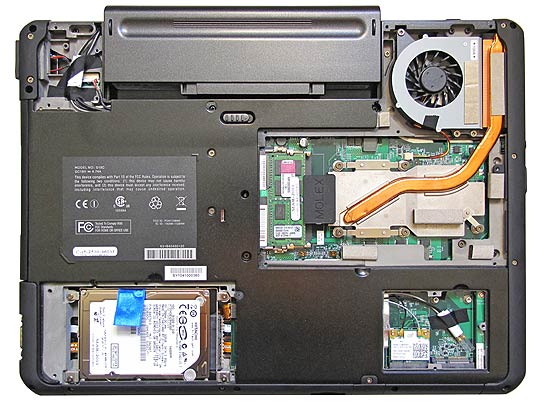
On top you can see the 11.1 Volt/ 4,400mAH battery that slides into the back of the system netbook-style (and with 48 watt-hour also provides no more than netbook style capacity. It secures into place with a spring-loaded lever. A higher capacity 9-cell battery appears to be optionally available.
On the bottom left is the storage compartment that houses the hard disk. The disk sits in a separate shock-mounted caddy. Our tester came with a 320GB Hitachi TravelStar spinning at 5,400 rpm and using a 3Gb/s SATA interface. GammaTech offers hard disks up to 750GB, and also 64, 128, 256 and even 512GB solid state disks. If additional ruggedness and performance are an issue, SSDs bring substantial benefits.
On the bottom right is there is a wireless communications compartment with two mini PCIe slots. In our unit, one was taken by an Intel WiFi Link 1000 single band 802.11b/g/n "half card" module (see Intel Centrino Wireless-N 1000 here). The little module supports some Intel-only features, such as Intel Wireless Display that allows wireless sharing of video, pics or internet on wireless-enabled HDTVs. Both the main and the auxiliary antenna were connected. The second mini PCIe slot sat empty, dual antennas ready for connection to a WWAN radio module or similar.
Underneath the largest of the four covers are the Durabook's two DDR3 SODIMM memory slots and the thermal hardware that keeps the machine cool even with its rather powerful processor. It consist of a metal heat spreader plate conducting heat away from the Intel Core processor and accompanying chipset. A copper heat pipe then transfers the heat to the system's fan.
Note that these covers are not meant to seal the unit. They do not have rubber seals or gaskets, and some have air vents.
Keyboard and touch pad
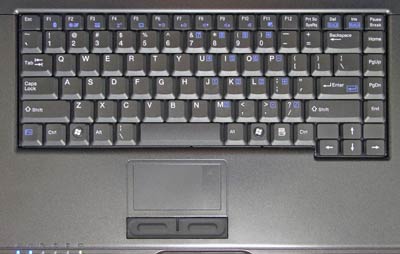 The Durabook S15C's keyboard is full-scale and has 88 keys. The key design is standard notebook (as opposed to the "chiclet" style keys often found in rugged machines) and the keys are black with white letters, numbers and symbols. Functions are indicated in blue. The keyboard doesn't have a backlight. The Durabook S15C's keyboard is full-scale and has 88 keys. The key design is standard notebook (as opposed to the "chiclet" style keys often found in rugged machines) and the keys are black with white letters, numbers and symbols. Functions are indicated in blue. The keyboard doesn't have a backlight.
Below the keyboard is the unit's touch pad. It is a properly sized and flush-mounted affair with two large and very responsive mouse buttons in front of it. The touch pad is a pleasure to use, but it can't be operated with gloves on (though it does pick up through some materials, like suede).
The lower left corner of the picture you can see six notification lights. Above the keyboard on the right are the power button and the wireless on/off button. Both have a strong blue backlight and they are clearly marked (in addition to the power button being round and the WiFi button oval).
Performance
When IBM introduced the first PC some 30 years ago, consumers had no performance choice. All IBM PCs came with an Intel 8088 processor, and for several years after that, all IBM PC clones, too. And the Intel 8088 processor was dirt-cheap. Today, Intel makes literally hundreds of different processors, and some cost more than entire notebooks and desktops, and not just the basic ones. What this means is that performance has become relative. Desktops generally offer as much performance as is possible for a given price, whereas with notebooks it is usually a rather more complex compromise between performance, size, weight, battery life and cost. In general, high performance processors generate more heat and use more battery power. You can fix that with a fan and a bigger battery, but then the computer may get too large and heavy. So every notebook manufacturer must find just the right balance between performance, battery life, size, weight and cost. So how did GammaTech address this issue in the S15C?
They decided to give users several choices. From what we can tell, as of this writing (mid-May 2011), GammaTech offered the following Intel processor options:
|
GammaTech Durabook S15C: Intel processor options
|
|
PROCESSOR COMPARISON
|
Core i5
|
Pentium
|
Core i3
|
Core i5
|
Core i7
|
|
Model
|
460M
|
P6200
|
380M
|
560M
|
640M
|
|
Cores/Threads
|
2/4
|
2
|
2/4
|
2/4
|
2/4
|
|
Base Clock Speed
|
2.53 GHz
|
2.13 GHz
|
2.53 GHz
|
2.66 GHz
|
2.80 GHz
|
|
Turbo Speed
|
2.8 GHz
|
NA
|
NA
|
3.2 GHz
|
3.46 GHz
|
|
Thermal Design Power (TDP)
|
35 watts
|
35 watts
|
35 watts
|
35 watts
|
35 watts
|
|
Smart Cache
|
3MB
|
3MB
|
3MB
|
3MB
|
4MB
|
|
Graphics max speed
|
667 MHz
|
667 MHz
|
766 MHz
|
766 MHz
|
766 MHz
|
|
Intel Hyper Threading
|
Yes
|
No
|
Yes
|
Yes
|
Yes
|
|
Intel Trusted Execution
|
No
|
No
|
No
|
Yes
|
Yes
|
To be honest, we're not quite sure why GammaTech offers so many processor options that all seem fairly close in terms of performance and features, but hey, choice is good.
To see what kind of performance the big Durabook can put on the table with its beefy 2.53GHz Intel Core i5-460M processor, we ran our standard benchmark suite, Passmark Software's PerformanceTest 6.1, that runs about 30 tests covering CPU, 2D graphics, 3D graphics, memory, and disk and then computes scores for each category and an overall PassMark score. We also ran our second benchmark suite, CrystalMark, for confirmation and additional information. For comparison, we included benchmark results of a recently tested Durabook D14RM, the semi-rugged GD-Itronix 6000 and Getac 9213, and the fully rugged GD-Itronix Topaz, Getac B300 and Panasonic Toughbook 31. These are mostly not direct competitors of the 15.5-inch Durabook, but simply show where the test machine fits into the current performance landscape.
The results are as follows:
|
Gammatech Durabook S15C Benchmarks and Comparisons (PassMark 6.1, 32-bit version)
|
|
PERFORMANCE COMPARISON
|
Gammatech
|
Gammatech
|
GD-Itronix
|
GD-Itronix
|
Getac
|
Getac
|
Panasonic
|
|
Model
|
S15C
|
D14RM
|
6000
|
Topaz
|
9213
|
B300
|
CF31
|
|
Processor Type: Intel
|
Core i5
|
Core 2 Duo
|
Core 2 Duo
|
Core 2 Duo
|
Core 2 Duo
|
Core i7
|
Core i5
|
|
Processor Model
|
M460
|
T9600
|
T9400
|
T9400
|
SU9400
|
LM640
|
M540
|
|
CPU Speed
|
2.53 GHz
|
2.80 GHz
|
2.53 GHz
|
2.53 GHz
|
1.40 GHz
|
2.00 GHz
|
2.53 GHz
|
|
Turbo Speed
|
2.80 GHz
|
NA
|
NA
|
NA
|
NA
|
NA
|
NA
|
|
Thermal Design Power (TDP)
|
35 watts
|
35 watts
|
35 watts
|
35 watts
|
10 watts
|
25 watts
|
35 watts
|
|
BatteryMon min draw
|
11.0 watts
|
16.2 watts
|
14.5 watts
|
20.0 watts
|
6.2 watts
|
8.9 watts
|
12 watts
|
|
CPU Mark
|
949.3
|
1,827.1
|
1,538.8
|
1,636.4
|
838.4
|
926.6
|
1,008.8
|
|
2D Graphics Mark
|
280.3
|
261.1
|
294.8
|
447.6
|
176.0
|
258.3
|
249.6
|
|
Memory Mark
|
701.0
|
736.4
|
696.8
|
668.9
|
347.9
|
629.5
|
737.7
|
|
Disk Mark
|
520.5
|
619.3
|
378.0
|
615.8
|
390.2
|
575.1
|
589.1
|
|
3D Graphics Mark
|
308.1
|
134.7
|
180.7
|
238.8
|
102.0
|
272.7
|
352.3
|
|
Overall PassMark
|
562.8
|
802.4
|
679.5
|
776.7
|
403.9
|
547.4
|
600.2
|
The benchmarks show that our Intel Core i5-based Durabook performs quite well. The overall PassMark score of 562.8 is roughly three times what we see in a typical netbook, and comparable to the more performance-oriented semi-rugged and rugged notebooks available today.
Benchmarks, of course, are notoriously difficult to compare over different processor types, and results often greatly vary from benchmark to benchmark. When you look at the CPU Mark scores, machines with older Core 2 Duo chips actually scored higher than newer Intel chips at comparable clock speeds. Go figure on that one. Overall, the Durabook scored consistently good results without weakness in any of the tests.
We did notice one weirdness, and it's one that we had already come across when we benchmarked the Durabook D14RM: our initial benchmarks for the S15C were unexpectedly low and did not seem up to par at all with its impressive specs. We made sure the system was actually set to "High Performance" in the Windows 7 Power Options control panel and the processor cores were running at full speed. Everything was fine. Yet even after running the benchmarks twice more, the results did not improve. With Windows it's often, "when in doubt, reboot," and so we did that. Lo and behold, the Durabook now seemed a changed machine and sped through the benchmarks almost twice as fast.
Performance bottom line: Our Durabook with its mid-range i5-M460 was a good performer and can hold its own in good company. When selecting the options on a S15C, unless cost is the primary issue, we'd probably stay away from the Pentium (only two threads) and the i3 (no turbo boost). The high-end i5 and i7 options have slightly faster graphics and higher maximum Turbo Boost frequency, but for a real performance boost, switching from a hard disk to a solid state disk (GammaTech offers several Intel SSD options) and adding the optional nVidia N11M GE2-S discrete graphics would probably make a far bigger difference.
Power and Battery Life
While the Durabook S15C is a quick machine, it does have a rather small battery for such a big notebook. It has hardly more capacity, in fact, than the battery in my little Acer Aspire One netbook that I occasionally use around the office and on trips. It would be unfair to compare the Durabook's battery capacity with that of some of the leading rugged notebooks that come with very high capacity batteries designed to last a full shift. Semi-rugged and durable notebooks, on the other hand, are not designed to be away from electrical outlets for extended periods of time, and they generally have smaller batteries.
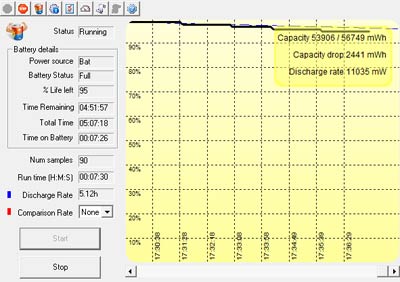 As is, GammaTech claims up to 3.5 hours of battery life with the standard battery, and so we tested that using the PassMark BatteryMon benchmark utility. With Windows power setting on "High Performance," all radios on, and the screen set to its brightest setting, we saw a draw of about 16.5 watts, corresponding with a theoretical battery life of about 3:40 hours. With 1080p HD video playing, draw jumped to about 2.5 watts, with battery life dropping to just over two hours. Interestingly, BatteryMon, incidentally, judged the battery capacity to be 56.7 watt-hours, and not 48 watt-hours. As is, GammaTech claims up to 3.5 hours of battery life with the standard battery, and so we tested that using the PassMark BatteryMon benchmark utility. With Windows power setting on "High Performance," all radios on, and the screen set to its brightest setting, we saw a draw of about 16.5 watts, corresponding with a theoretical battery life of about 3:40 hours. With 1080p HD video playing, draw jumped to about 2.5 watts, with battery life dropping to just over two hours. Interestingly, BatteryMon, incidentally, judged the battery capacity to be 56.7 watt-hours, and not 48 watt-hours.
With power management set to "Power Saver," all radios off, and the display set to minimum backlight (which is still plenty enough for indoor use), idle power draw dropped all the way to about 11 watts, a very good value for a system this powerful with such a large display. This meant a theoretical battery life of about five hours. Turning on the radios added about a watt to 12 watts, and setting the backlight to high made draw rise to about 14 watts. This means the Durabook has a very frugal backlight!
And if you wonder how the Windows power management setting affects performance, we measured an overall Passmark score of 562.8 with the machine in Windows "High Performance" mode, and 437.4 with the machine in "Power Saver" mode. Disk performance stayed the same, but everything else decreased by 20-25%.
If battery life is an issue, GammaTech offers a higher capacity (but same size) 9-cell battery for a roughly US$100 upgrade price.
Display
The Durabook S15C's large display measures 15.6 inches diagonally and it uses the increasingly popular 1366 x 768 pixel format that translates into a wide-format 16:9 aspect ratio. That's like a standard 1024 x 768 XGA display, but about 30% wider. It's also a format popular in small and lower-end HDTVs, and the format is often referred to as 720p HD. Now that everyone's used to wide format displays, this screen givs the Durabook a sleek, modern look, compared to some of the popular rugged notebook lines that continue to stay with the old 4:3 aspect ratio for backward compatibility reasons.
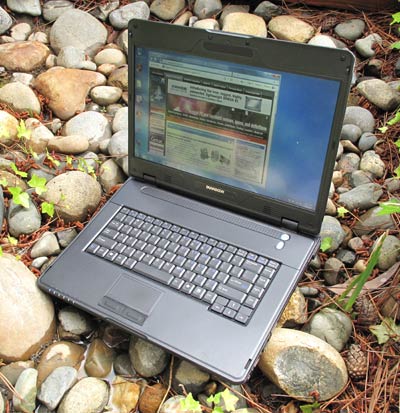 I wish I could report more on the nature and technology of the display, but available information is sparse. Gammatech literature describes the S15C's screen as "brilliant" and the official brochure lists the display as sunlight readable with anti-reflective coatings and an enhanced-brightness LED backlight. However, the specs do not include a nits brightness rating. Optical coatings and enhanced brightness, of course, are the current recipe for outdoor/sunlight viewability. I wish I could report more on the nature and technology of the display, but available information is sparse. Gammatech literature describes the S15C's screen as "brilliant" and the official brochure lists the display as sunlight readable with anti-reflective coatings and an enhanced-brightness LED backlight. However, the specs do not include a nits brightness rating. Optical coatings and enhanced brightness, of course, are the current recipe for outdoor/sunlight viewability.
As is, what we can report is that the Durabook's display is indeed nice and bright, and bright enough for some outdoor use. And while its surface is quite glossy, the gloss is not quite as bad that on most of today's consumer notebooks, and there seems to be a degree of anti-glare applied to it. The picture on the right is unretouched and shows that the Durabook display remains nicely viewable outdoors. There's a bit more reflection than we like, and users need to position the machine to minimize the effect, but it's workable.
For a comparison, we chose another full-size machine that we often use around the office, and even work on outdoors, with good results—my personal 15-inch Apple MacBook Pro. It's similar in size to the Durabook and its display has an excellent, and well deserved, reputation.
The picture below shows the two machines outdoors on a fairly bright late spring day. Both display backlights are cranked up to maximum brightness, and both remain quite viewable. The MacBook display shows a bit of glare on its semi-matte displays and the Durabook screen takes on a blueish hue.
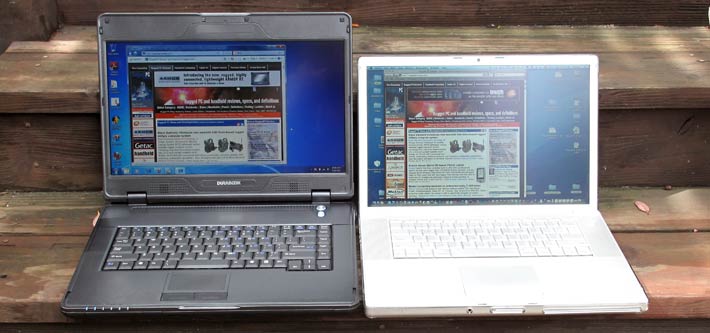
So without knowing a lot of specifics, the Durabook display worked quite well for us, especially for a machine that was not specifically designed as a fully rugged outdoors system.
Another display quality that we cherish are wide horizontal and vertical viewing angles. The Durabook display has an almost perfect horizontal viewing angle, but the vertical one is rather narrow, with lots of chromatic aberrations and color shifting as you change the viewing angle.
And a word about resolution: While wide format 1366 x 768 is perfect for watching HD video, it is actually fairly low-res for such a large display. The advantage is that everything is nice and large and clear, but those working with dense, complex applications may wish for higher resolution. GammaTech's S15C brochure does, in fact, refer to a 1920 x 1280 FHD+ resolution option, or full 1080p in HDTV speak, and that would be very nice.
How rugged is this Durabook?
The name "Durabook" certainly invokes connotations such as "tough," "durable," "reliable," etc., and Gammatech does refer to it as a "rugged notebook." Unfortunately, there are no standards on what exactly defines "rugged" or "semi-rugged" or even "durable" or "business-rugged" or whatever else the industry has come up with. Even the often cited MIL-STD-810F and its successor, MIL-STD-810G, really only describe the procedures for a variety of environmental tests. What it means is that the terms are quite elastic.
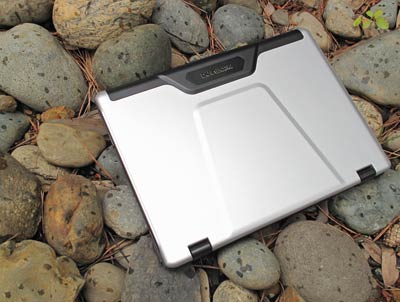 As is, GammaTech really only claims resistance to drops, shock, and spills, and describes the design limits in some detail. As is, GammaTech really only claims resistance to drops, shock, and spills, and describes the design limits in some detail.
For drops, testing is conducted in accordance with the procedures described in MIL-STD-810G, Method 516.6, Procedure IV. Drops are from a height of 29 inches, which is about the height of a tallish desk, onto 2-inch plywood over concrete. The machine is then dropped once on its six faces (front, back, top, bottom, left, and right) with the display closed and unit turned off. After each drop, the machine must be able to boot. That is not very impressive compared to the four (and higher) foot drops onto concrete some of the ruggeds can do, but it's in line with, for example, the new semi-rugged Panasonic Toughbook 53.
GammaTech also states shock and vibration resistance in testing similar to MIL-STD-810G, Method 514.6, Procedure I, Category 4, Fig 514.6C-1 which simulates traveling in a truck on a highway for 1,000 miles, compressed into 60 minutes. In addition, also adherence to integrity exposure as shown in Fig.6E-1 in the same section, as well as ASTM4169, Truck Transport, 11.5.2 Random Test, Assurance Level II (ASTM stands for American Society for Testing and Materials. The D 4169 standard sets tests and requirements for strength, durability and protective capability of packaging. Level II stands for medium test intensities and is most commonly used).
On the sealing front, GammaTech concentrated on spill resistance. While the wording mentions IP54, the emphasis here is really on protection against inadvertent spills.
There are no operating temperature specs or some of the other specs commonly listed for semi-ruggeds and ruggeds (like altitude, humidity, temperature shock, etc.)
If you dig a bit deeper into GammaTech's materials and origin, past the official specs, you'll find that the machine offers quite a bit of vibration protection (as is evident from looking at its insides with all its shock absorption and magnesium construction) and that it's really tougher than the few supplied specs might lead one to believe. One of the problems here is that the machine can be ordere din so many different configurations that it's not always clear from the documentation and website what you can get and what specs apply.
Summary: The GammaTech Durabook S15C
The Gammatech Durabook S15C is a 6.5-pound notebook computer designed to be tougher and more durable than standard consumer notebooks, but without the extra size, weight and cost of a fully rugged design. It's a very solid, trust-inspiring machine with a large 15.6-inch wide-format display, good connectivity, and good day-to-day functionality.
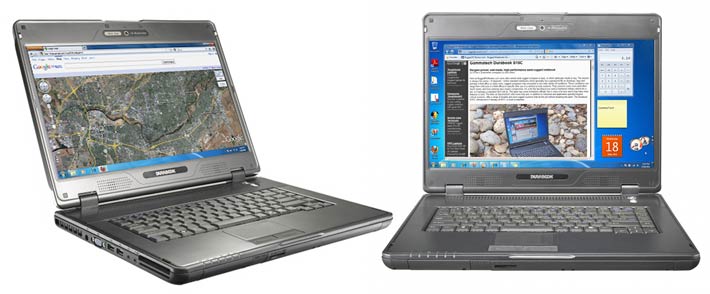
Starting price of the Durabook S15C is low compared to fully and even most semi-rugged laptops, only around US$1,500 or so for a bare-bones machine. A mid-range version like our test unit is still only in the US$1,650 range, a good value for the money.
Despite its low starting price, the Durabook is a every good performer. Our review unit came with the mid-range 2.53GHz Intel Core i5-460M processor and achieved very good overall benchmark results. The standard battery, however, is not very powerful, and battery life between charges is limited. The optional higher capacity battery is recommended.
The Durabook S15C has a bright 1366 x 768 pixel wide-format display that remains usable outdoors without much reflection and glare. There is not touch screen, but a 1920 x 1080 pixel display option is available.
While it's not immediately obvious by the fairly modest ruggedness claims, the Durabook is an exceptionally well constructed machine. Its magnesium alloy chassis should hold up for a long time, and there is plenty of shock-mounting as well as plenty of internal protection. However, while the unit can handle spills onto its keyboard and such, it is not waterproof (open cooling vents to inside on side and bottom). Examine ruggedness specs to see if they match your requirements.
Overall, the Durabook S15C with its large, modern wide-format display and late model Intel processor options is a good deal for anyone who needs a powerful, highly configurable notebook that is significantly tougher than standard consumer laptops and should hold up well in daily use.
GammaTech Durabook S15C highlights:
- Very solid and well-made
- Very good performance with Intel Core i5 processor (i3/i5/i7 available)
- Bright display with good outdoor viewability and modern 16:9 1366 x 768 pixel wide format
- 1920 x 1080 display option
- Display is not glossy
- Excellent keyboard and touch pad
- Very solid magnesium-alloy chassis and very clean construction
- Low starting price, and even well-equipped a good deal
- Spill-resistant design
- GammaTech does built to order (BTO)
But keep in mind:
- Narrow vertical viewing angle
- Small standard battery
- No HDMI port
- Limited ruggedness (2.5 foot drop)
- No operating temperature range listed
- Fan a bit noisy and comes on often (adjustable in BIOS setup)
- Adding options can quickly double the cost
– Conrad H. Blickenstorfer, May 2011
|
Gammatech Durabook S15C Specifications
|
| Added/changed |
Added 5/2011
|
| Type |
Semi-rugged notebook computer
|
| Processor |
Intel Core i5-460M with 3MB Intel smart cache (also available with Intel Core i3-380M, i5-560M, i7-640M) |
| CPU speed |
2.53GHz (max Turbo Boost speed 2.8GHz) |
| Chipset |
Intel HM55 |
| OS |
Windows 7 Professional |
| Graphics Controller/Chipset |
Intel HM55 Integrated graphics (nVidia N11M GE2-S discrete graphics optional) |
| Memory |
2-8GB DDR3-800/1066/1333MHz SDRAM |
| Display |
Daylight-readable transmissive TFT with 8-step adjustable backlight
|
| Display size and resolution |
15.6" HD (1366 x 768 pixel); FHD+ 1920 x 1080 pixel option, enhanced Bright 500 nits DuraBrite LCD option, Sunlight Readable option
|
| Digitizer/Pens |
Optionally available
|
| Keyboard |
Integrated 88-key, 100%-scale |
| Storage |
Shock-mounted 320GB 5400rpm SATA Hitachi Travelstar (up to 7200rpm 750GB hard drives and up to 600GB Intel SSD (MLC) optionally available) |
| Multimedia Pocket |
Media Bay has Super Multi DVD/RW drive with bezel lock, can accommodate optional second hard drive |
| Slots |
1 Type II PC Card, 1 4-in-1 card reader (SD, MMC, MS, MS Pro), 1 SIM, SmartCard (opt.) |
| Housing |
Magnesium alloy chassis |
| Temperature |
32 to 104 degrees Fahrenheit operating |
| Humidity |
10 to 90% non-condensing |
| Vibration |
MIL-STD-810G, Method 514.6, Procedure I + ASTM4169, Truck Transport, 11.5.2 Random test, Assurance Level II |
| Sand and Dust |
NA (C-face (keyboard and display) is spill resistant, including keyboard, buttons and indicators) |
| Explosive Atmosphere |
NA |
| Enclosure Class |
NA |
| EMI |
NA |
| Shock: Functional |
MIL-STD-810G, Method 516.6, Procedure I -- 40g, 11ms Operating |
| Shock: Transit Drop |
MIL-STD-810F, Method 516.4, Procedure IV -- 26 drops from 30 inch height onto 2 inch plywood with unit off and display closed |
| Certifications |
EPEAT Silver, Energy Star 5.0, RoHS Compliance |
| Size (inches) |
14.6 x 10.9 x 1.5 inches |
| Weight |
6.5 pounds as tested, with battery and optical drive |
| Power |
11.1V/4,440mAH 48 watt-hour Li-Ion battery ("3.5 hours"), optional 9-cell battery ("5 hours") |
| Communication |
Intel WiFi Link 1000 802.11b/g/n (optional Intel 6200 AGN); optional Bluetooth v2.1 + EDR, optional WWAN or GPS in 2nd Mini PCI Express slot, optional 1.3mp webcam |
| Interface |
1 RS-232, 3 USB 2.0, IEEE 1394, VGA, RJ-45 LAN, RJ-11 modem, audio in/out
|
Price |
Starting at US$1,500 |
| Website |
www.gammatechusa.com |
| Warranty |
2 years (mail-in); optional 2/3/4/5 year no-fault warranties |
|
|








